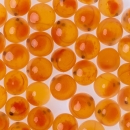What We Do
Each year, the U.S. Fish and Wildlife Service’s National Fish Hatchery System raises and distributes millions of fish and aquatic species to support conservation efforts across the country.
In 2024, the system distributed 223 million fish and aquatic wildlife to enhance state and tribally managed recreational fisheries, boost local economic development, fulfill tribal trust responsibilities, recover threatened and endangered species, and prevent at-risk species from becoming endangered.
FY 2024 Distribution Snapshot Breakdown
- 122 million – Fish and aquatic wildlife stocked directly by national fish hatcheries.
- 60 million – Fish and eggs transferred to conservation partners, including states and tribes.
- 41 million – Fish or aquatic wildlife transferred internally for program support or future release.
Why are National Fish Hatcheries Stocking fish
- 77 million –Mitigation – Support for fisheries that have been impacted by a federal dam.
- 73 million –Recreation – Enhance state and tribally managed recreational fisheries.
- 52 million – Restoration and Recovery - Recover federally listed threatened or endangered species and prevent at-risk species from becoming endangered.
- 17 million – Tribal Trust and Subsistence - Support for tribes’ self-determined conservation purposes within their jurisdictional waters.
- 4 million – Capacity Building - Ensure hatcheries meet current and future conservation needs.
Supporting Threatened and Endangered Species
- 12 million – Threatened or endangered animals released to bolster wild populations and preserve genetic diversity.
- 28 – Federally endangered species supported.
- 14 – Federally threatened species supported.
Data is updated periodically and this page may not include the most recent information. All data is accurate as of May 2025.




